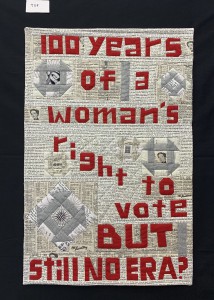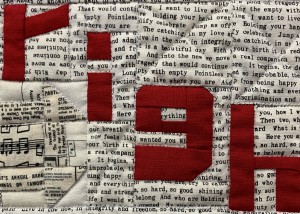I finished this just in time for the deadline of January 4, 2020. It’s a “story quilt,” so here’s my story:
I remember when the first issue of Ms. Magazine hit the news stands. My mom bought it and read it. Then my sister and I devoured it from cover to cover. After that, Mom subscribed so that all of us could read it every month. I got my own subscription when I went away to college.
I was a teenager in the 1970’s when I first heard about the Equal Rights Amendment, (the ERA.) I was shocked to learn that it hadn’t been ratified yet, and it wasn’t part of the constitution. How could the constitution leave out something so fundamental? “Equality of rights under the law shall not be denied or abridged by the United States or by any State on account of sex”. The amendment needed to be ratified by 38 states before becoming part of the constitution. We were one state away from ratifying it, when the time limit ran out.
Twenty five years ago, my husband and I were thinking about names for our not yet born baby. The girl’s name we picked out happened to have the initials: ERA. Although we hadn’t done it deliberately, we very much liked that the initials of our child’s name would spell out ERA. (I didn’t change my name when I married, and my husband’s last name begins with an “A”). Frequently in emails, I would write “ERA,” instead of writing out my child’s full name. On my phone, “ERA” would flash when my first born called home. This year that child, now an adult, decided to legally change their first name to another name that starts with an “E,” that better reflects who they are now. I hesitantly asked, ‘what about your middle name?’ ‘No change’ was the answer! It turns out that ERA loves being ERA!
I wrote a haiku for my quilt about the ERA, but like many things in life, the words couldn’t be contained on just three lines.
100 years of
A woman’s right to vote. BUT
still no ERA?
The background fabric, full of words and newspaper images symbolizes all the talk, arguments, and debates about the ERA that have surfaced since it was first introduced in Congress in 1923.
The scope of work available to women has completely transformed over the last 100 years. In designing this quilt I chose the “churn dash” block, named for part of a butter churn, to represent women’s work of 100 years ago. However the fabric in these blocks represents the work that women do today. Fabric with mathematical equations represents scientists, mathematicians, and technology workers. Radio circuitry fabric represents women in the media; film fabric represents women in the film industry; recipe fabric represents women in the food industry; fabric with a spool of thread represents women in the garment industry; and the sheet music fabric is for the music industry. In the center of largest churn dash is a mariner’s compass to help women find their way in the world.
Here’s a detail:
Someone asked how I got the newspaper onto the fabric. It’s all commercial fabric! I bought fabric that looked like a newspaper, or like typed lines of words, or math equations. There are ways of printing whatever is on your computer screen onto fabric that’s attached to paper and goes right through your printer like regular paper, but I didn’t use that for this quilt.
Here’s a link to more info about the challenge:
https://www.centuryofwomensprogress.com/how-to-enter
#EBHQ #Voices In Cloth



I love your ERA quilt! And congratulations for getting it finished for the competition.
I’ve been advocating for the Equal Rights Amendment for decades and was sooooo happy when Illinois FINALLY voted for it. Virginia looks to be next.
Thanks, Nann!
I love your blog.. very nice colors & theme.
Did you create this website yourself or did you hire someone to do it for you?
Plz reply as I’m looking to construct my own blog and would like to know where u got this
from. thanks a lot https://www.Tshirts-supplier.com
Lisa Tait of Silvertop Graphics made this website for me. Her contact info is below:
Silvertop Graphics
PO Box 366
New Kingston, NY 12459
silvert@catskill.net